Google predictive search (now known as Autocomplete) is a pretty useful tool for looking into the soul of your fellow man.
Since its introduction in 2004, it’s frequently ended up in the spotlight. Sometimes for accidental Autocomplete Poetry, and sometimes for somewhat darker reasons.
Example: I just typed “what would happen if you…” into Google. The results speak for themselves.
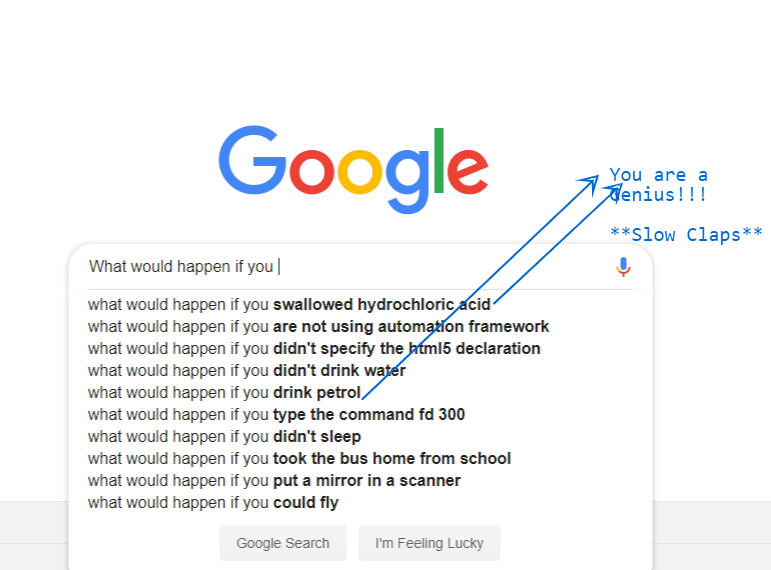
Jokes aside though, Google predictive search has the power to influence user behavior. And there is thus no denying that it’s also a handy tool for online marketers.
From maintaining your brand reputation to uncovering user intent, you can fill in some gaps in your SEO strategy by embracing Autocomplete.
Let’s cover how predictive search works and how you can make the most of this opportunity.
What is Google Predictive Search?
Predictive search is primarily a convenience feature for users. It’s designed to guess a searcher’s intent before they finish typing it in.
While it does seem like the suggestions might be handpicked by someone with a weird sense of humor, it’s of course 100% algorithmic.
According to Google, Google Autocomplete reduces typing by 25% on average. This might not sound impressive at first, but cumulatively it can save up to 200 years of typing time in one day.
This technology has of course changed over the years, so let’s take a quick look in the history books.
First launched in 2004, Google dubbed it Google Suggest. Their next big step in the realm of the predictive search was Google Instant, which went live in 2010.
Unlike Autocomplete, Google Instant actually updated the search results in real time. No need to hit the enter button.
Sounds great on paper. Not so much in practice.
As it turned out over half of all Google users are on mobile and Google Instant provided results that weren’t very user-friendly for them.
That’s not to mention the influx of litigation they faced over the years, related to Google Instant. Ultimately, Google had to Shut down Google Instant.
Autocomplete is, on the other hand, an integral part of the search experience and still going strong.
How Does Google Predictive Search Work?
Let’s start with a fun fact: Google now processes over 3.5 billion searches every day.
RankBrain is responsible for parsing this massive amount of data, and leveraging it to deliver more sophisticated and personalized search results.
While we have a pretty good understanding of what makes autocomplete tick, but of course Google has not (and will not) reveal the inner workings of their algorithm.
But, based on reasonable assumptions and years of research, it’s safe to say that the following factors likely impact results.
Search volume
It probably comes as no surprise that this is an important determinant of what shows up in autosuggest.
Popular terms usually fit well with users’ search intent. Since Google can’t read your mind, they go for the next best thing: showing phrases that others have already searched for.
But it’s not so simple. Sometimes additional factors may have greater importance based upon the context of a search, and the user’s location…
Location
Not everyone sees the same suggestions for the same keyword. User location and language directly influence the search predictions.
Take a look at this image:
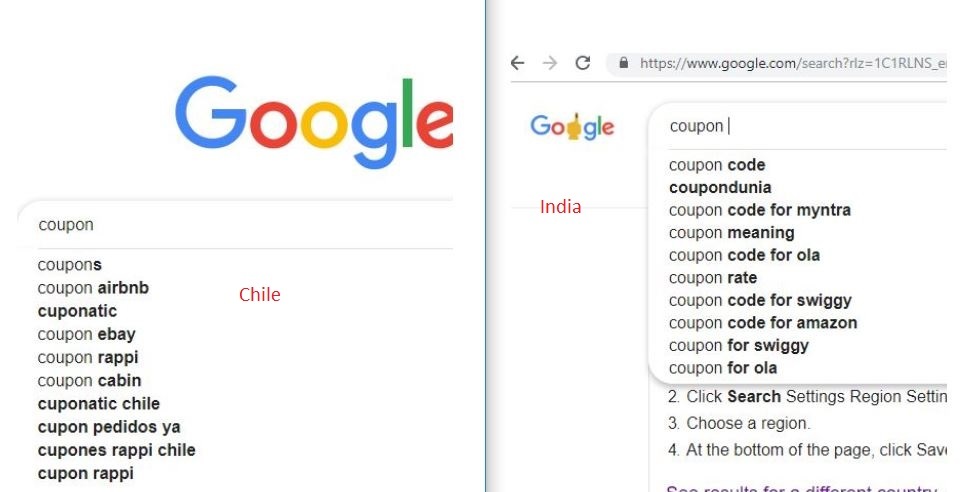
Here is a side-by-side comparison of search predictions displayed on Google Chile and Google India. Clearly, suggestions are tailored based on local search trends.
For example, Rappi is a popular on-demand delivery service based on South America. Therefore it makes sense to display suggestions related to Rappi on Google Chile.
However, Rappi doesn’t operate in India. So of course it’s absent when you’re searching google.in.
Now Google doesn’t stop at just tracking IPs. Even the physical location of your devices is taken into account. That’s why sometimes Google Autocomplete predictions can vary even in different neighborhoods of the same city.
Search history
You hopefully already know this, but Google collects data from all of your online activities. That includes searches, mail, maps, calendars… literally anything that they can get their hands on.
Privacy issues aside, this data is certainly critical to Google’s ability to personalize your search results, and generate tailored autocomplete suggestions.
So the predictions you see will often include references to your previous searches and interests.
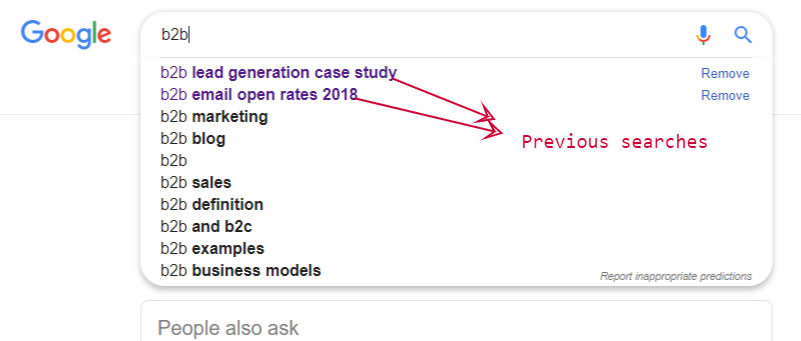
As you can see above, it’s not uncommon for me to search about b2b marketing related topics!
Content freshness
Sometimes Google will give preferential treatment to newer (fresher) topics than just high search volume terms.
This is especially true during major international events.
For instance, if you search the keyword “London” now, you may not see any autocomplete suggestions related to the Olympics, but check back in a year and you better believe they’ll be there!
How Can Google Autosuggest Enhance Your SEO Efforts
So we’ve covered what predictive search is, and how Google autocomplete likely works behind the scenes.
Now let’s get to the red meat. How can you leverage predictive search to enhance your own SEO efforts?
Generating keyword ideas (especially long-tail)
You’ll notice an interesting trend if you’re a regular reader.
Each guide I put together, starts with a section calling out the necessity of solid keyword research.
That’s because it’s still the backbone of any successful SEO campaign. It’s just true!
I’d highly recommend you read the guide linked above if you haven’t already, but here’s a quick overview for those of you short on time.
Head terms (high-volume, single word keywords) are likely taken by big competitors, and they often don’t feature searcher intent anyways.
Long-tail keywords are going to be your bread and butter. They fill in content gaps and generate endless high-converting content ideas.
Here’s the thing about Google Autocomplete: your keyword research won’t end with it. But it will unlock the secret vault of high-converting, long-tail keywords.
Think of Google predictive search as a sidebar to your keyword research efforts.
Since Autosuggest gives credence to keyword popularity, that means that you’ll get an in-depth look at what’s trending with every Google search.
Pro tip: don’t forget to sign out of your Google account first to get an unbiased look at long-tail keywords.
Understanding searcher intent
For content to succeed, it needs to satisfy the searcher’s intent.
The very essence of an effective SEO strategy lies in understanding a target audience’s intent, and how you can best help those users achieve their goals.
Easier said than done. I know, I know.
Keywords often overlap various stages of user intent and it’s hard to untangle the underlying intent without the context.
For an example, let’s look at the keyword “cranberries”.
When someone types this into Google, they could be looking for any number of things.
- Pictures of cranberries
- Recipes that use cranberries
- The band most notable for their fame in the 90’s
Even two similar-looking search terms can imply completely different intent.
But guessing intent without seeing some context can be pretty tough, as you might imagine.
Thank goodness for autocomplete!
One glance at the recommended autocomplete suggestions can give you a pretty good idea what’s inside people’s minds when they’re typing in any given keyword.
Suppose we have two keywords: “toothpaste” and “best toothpaste”. They sound pretty similar, right?
Once you look at the predictive search results, you’ll see that the user intent behind these two are worlds apart.
“Toothpaste” is more of an informational query. “Best toothpaste” is a transactional query.
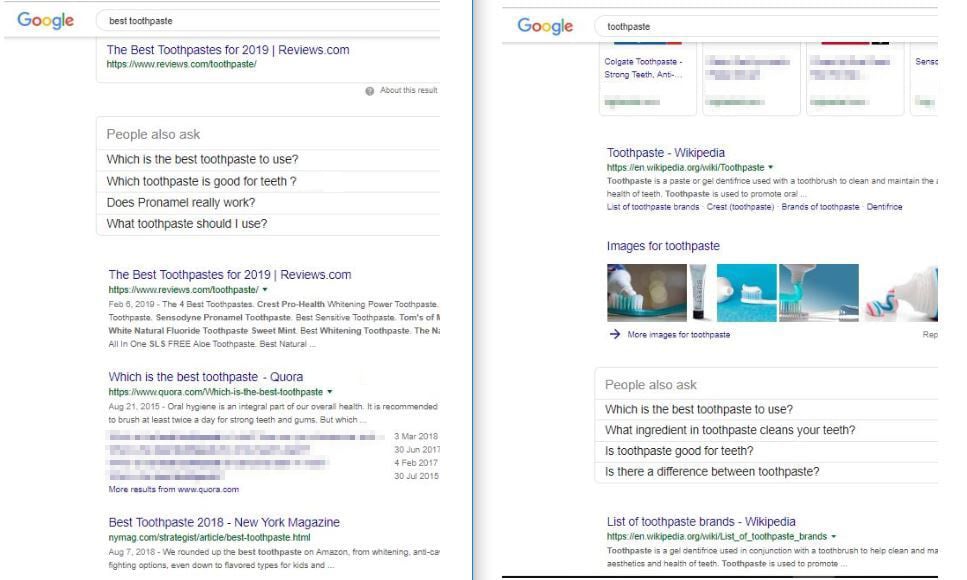
You can repeat this process for any keyword you’re interested in. Afterwards you should have a better idea of whether or not the searcher intent will suit your business objectives.
Monitoring your online reputation
When anyone searches for your business online, the first thing they’ll likely see is the autocomplete suggestions.
While this can be a boon, it can also be a nightmare. If you have negative predictions popping up, they can be a major headache.
Unfortunately, it can create a bit of a rolling snowball. As more people see the negative suggestion and click on it, the more likely Google is to give it credence.
Take, for example, Gillette.
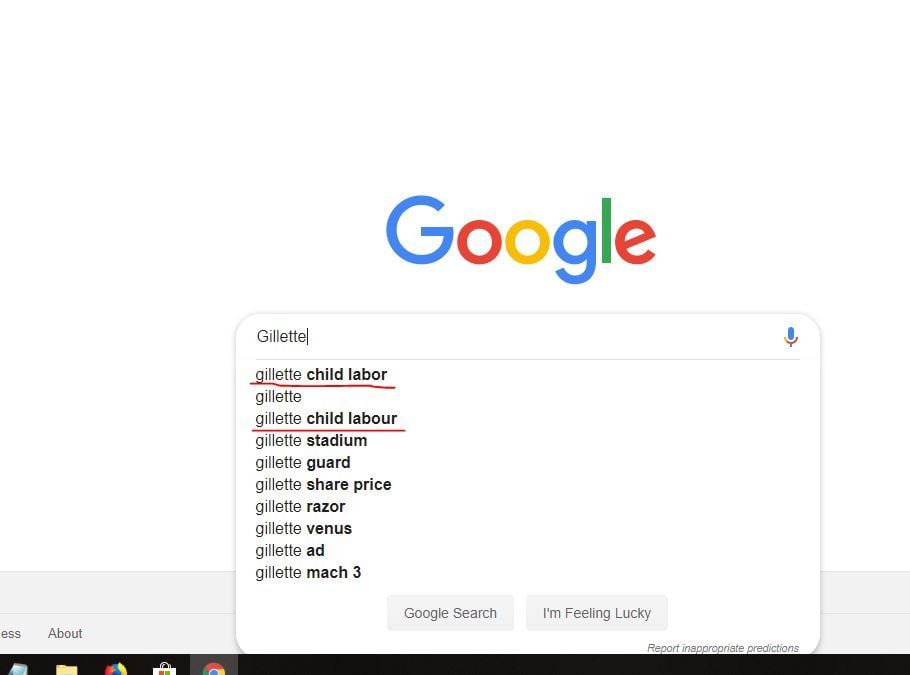
Oof. Not a position any business owner wants to be in.
We all know that branding is a critical component of any business. Furthermore, you can see now that it can even affect your SEO efforts.
So how can you avoid the trap of negative suggestions?
Eavesdropping on social media conversations and resolving customers’ complaints quickly is usually enough to secure your brand reputation most of the time.
But with that being said, life isn’t always fair. You may still find yourself facing autocomplete suggestions like “[your brand] lawsuit” or “[your brand] scam”.
It can be hard to get ahead of these, but being aware of them brewing can often help you resolve the issue outside of Google, leading to that suggestion dwindling away.
If all of that fails, you may need to try and “outrank” the negative suggestions. But that can be difficult, and require some hackish solutions.
End of the day, I am a big advocate of “an ounce of prevention is worth a pound of cure”.
Building your brand reputation by being an overall awesome brand always pays serious dividends.
Conclusion
Google predictive search has long been a useful tool for marketers, it just takes a bit of understanding to know how to leverage it to your benefit.
It’s also good for some laughs on your next lunch break.
I hope the advice above was useful to you, and you’re able to better navigate the SEO landscape with the help of autocomplete suggestions.








